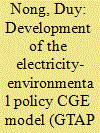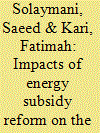|
|
|
Sort Order |
|
|
|
Items / Page
|
|
|
|
|
|
|
| Srl | Item |
| 1 |
ID:
150032


|
|
|
|
|
| Summary/Abstract |
To fulfill its Copenhagen pledges to control carbon emissions and mitigate climate change, China plans to establish a nationwide emissions trading scheme (ETS) in 2016. This paper develops a multi-sector dynamic computable general equilibrium model with an ETS module to study the appropriate ETS policy design, including a carbon cap, permit allocation and supplementary policies (e.g., penalty policies and subsidy policies). The main results are as follows. (1) To achieve China's Copenhagen pledge, the equilibrium nationwide carbon price is observed to be between 36 and 40 RMB yuan per metric ton. (2) The ETS policy has a cost-effective mitigation effect by improving China's production and energy structures with relatively little economic harm. (3) Various ETS sub-policies should be carefully designed to balance economic growth and carbon mitigation. In particular, the carbon cap should be set according to China's Copenhagen pledge. A relatively large distribution ratio of free permits, the output-based grandfathering rule for free permits, a penalty price (on illegitimate emissions) slightly above the carbon price, and a sufficient subsidy (from ETS revenue) are strongly recommended in the early stages to avoid significant economic loss. These designs can be adjusted in later stages to enhance the mitigation effect.
|
|
|
|
|
|
|
|
|
|
|
|
|
|
|
|
| 2 |
ID:
176763


|
|
|
|
|
| Summary/Abstract |
A new carbon price mechanism with full emission coverage is developed within the framework of a global computable general equilibrium model (GTAP-E-PowerS) to enhance the capacity and accuracy for climate change and energy policy assessment. The model developed is then used to examine the potential impacts of the carbon tax in South Africa. Results show that incorporation of non-CO2 emissions in the model significantly alters the results of which the economy of South Africa experiences higher costs compared to the case that only has CO2 emissions. When more sectors are included in the policy it also puts higher costs on the economy, as higher levels of emissions are subject to the carbon tax. Results also show that South Africa only experiences small tradeoffs from introducing the carbon tax in all scenarios. That is, with a tax rate of $9.15, the country is able to reduce its emission levels by 12.25%–15.6% at the costs of real GDP reduction by 1.17%–1.59%. Fossil-based industrial sectors are particularly worst off, while clean and renewable energy sectors strongly expand their production. The results indicate that South Africa is likely to move to a low carbon and sustainable economy with such a policy.
|
|
|
|
|
|
|
|
|
|
|
|
|
|
|
|
| 3 |
ID:
114301


|
|
|
|
|
| Publication |
2012.
|
| Summary/Abstract |
The European Union has committed itself to reduce greenhouse gas (GHG) emissions by 20% in 2020 compared with 1990 levels. This paper investigates whether this policy has an additional benefit in terms of economic resilience by protecting the EU from the macroeconomic consequences due to an oil price rise.
We use the GEM-E3 computable general equilibrium model to analyse the results of three scenarios. The first one refers to the impact of an increase in the oil price. The second scenario analyses the European climate policy and the third scenario analyses the oil price rise when the European climate policy is implemented.
Unilateral EU climate policy implies a cost on the EU of around 1.0% of GDP. An oil price rise in the presence of EU climate policy does imply an additional cost on the EU of 1.5% of GDP (making a total loss of 2.5% of GDP), but this is less than the 2.2% of GDP that the EU would lose from the oil price rise in the absence of climate policy. This is evidence that even unilateral climate policy does offer some economic protection for the EU.
|
|
|
|
|
|
|
|
|
|
|
|
|
|
|
|
| 4 |
ID:
118749


|
|
|
|
|
| Publication |
2012.
|
| Summary/Abstract |
What would happen to the economies of the former Soviet Union if they finally implemented a full-fledged free trade agreement? How would this change sector output, GDP, prices, international trade, and the economic welfare of the nation? How would it affect the economies of the FSU's other trading partners? This paper attempts to address these and other issues through the use of a computable general equilibrium model (CGE). The model is a large, multi-regional, multi-sectoral, multi-factor system of simultaneous equations. It introduces the "shock" of zero tariffs between all FSU's trading partners, and solves for a new economic equilibrium. There are some political and practical obstacles to the completion of such a trade agreement, so this mathematical model in some ways is just a hypothetical experiment. But an analysis of trade effects can nonetheless be useful to any policymaker in the former Soviet space.
|
|
|
|
|
|
|
|
|
|
|
|
|
|
|
|
| 5 |
ID:
132762


|
|
|
|
|
| Publication |
2014.
|
| Summary/Abstract |
Malaysia is paying a high level of subsidies on the consumption of energy (about 5% of its GDP). Therefore, reforming the energy subsidies, as planned by the government, will have a significant impact on household welfare and energy-intensive sectors, such as the transport sector. This study employs a computable general equilibrium (CGE) model to highlight the transmission channels through which the removal of energy subsidies affects the domestic economy. The findings show that the shock increases real GDP and real investment, while decreasing Malaysian total exports and imports. The removal of energy subsidies also decreases the aggregate energy demand, and, consequently, decreases the level of carbon emissions in the Malaysian economy. In addition, households experience significant falls in their consumption and welfare. The transport sector is significantly influenced through an increase in production costs due to an increase in the prices of intermediate inputs. The total output and total exports of the whole transport sector decrease while its imports increase. In addition, the use of all kinds of transport by households decreases significantly. The Malaysian energy subsidy reform, leads to an initial decrease in CO2 emissions and demand for electricity, gas, and petroleum products in the entire transport sector.
|
|
|
|
|
|
|
|
|
|
|
|
|
|
|
|
| 6 |
ID:
176858


|
|
|
|
|
| Summary/Abstract |
Energy security has been a major concern in developing countries because of rapid economic development and population growth, low power generation capacity, and unwell-developed transmission infrastructure. Vietnam in this context has been under energy security threats for more than a decade and is currently having a new power policy to strongly develop power generation and distribution networks. It is expected that the country's economy is able to develop substantially due to massively additional energy supply once completing the plants and distribution networks but the likely impacts are still undefined. This paper extends an economic electricity-detailed model to examine the potential impacts of such a new power policy in Vietnam. We find that the policy will decrease the prices of both fossil-based and renewable-based electricity significantly by 40%–78% under a 2030 target scenario, benefiting all sectors in the economy to substitute for fossil fuels. Households are particularly benefited as evidenced by 5.64%–19.19% increases in per-capita utility. Overall, the Vietnamese economy is significantly advantaged with real GDP increasing by 5.44%–24.83% over different scenarios, which are much higher than the findings in other countries. More importantly, the policy moves the country to a low-carbon energy structure in the near future.
|
|
|
|
|
|
|
|
|
|
|
|
|
|
|
|
|
|
|
|
|